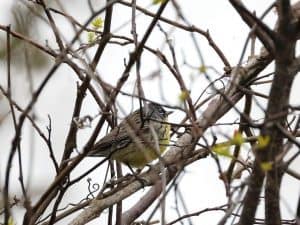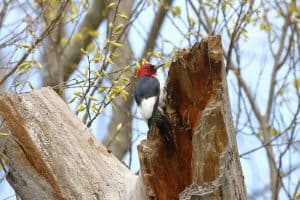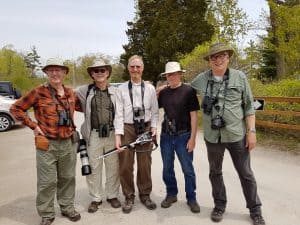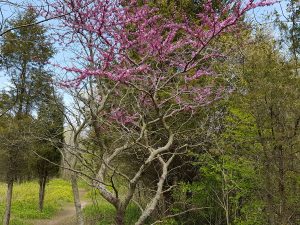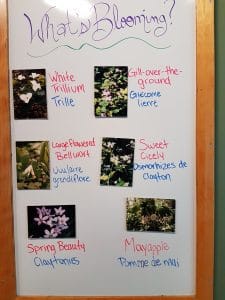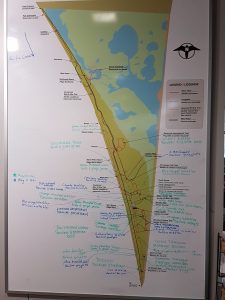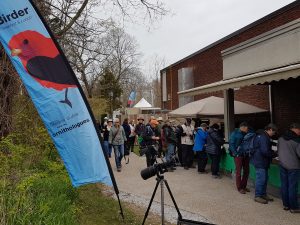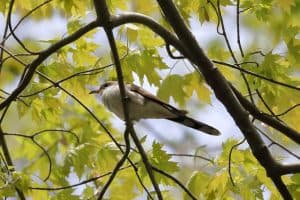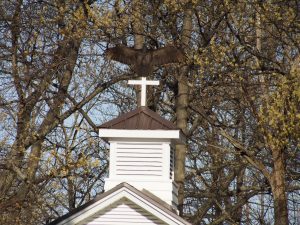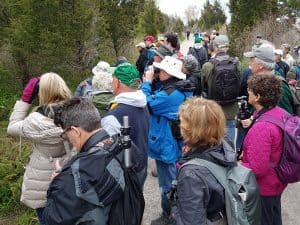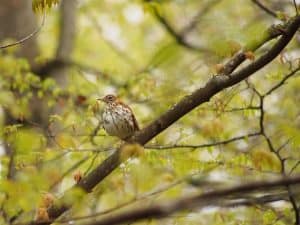It was the Kirtland’s warbler that made our morning. In the red cedar ten metres off the trail, the small grey and yellow bird was all but invisible. Only when it flitted from one branch to another was there any chance of seeing it – and it didn’t flit often. The small group that first spotted the bird had swollen to a hundred birders or more as word of North America’s rarest warbler spread almost instantaneously along the trails. Patience, however, eventually paid off as the bird flew up onto an exposed branch, sat cooperatively in the open and sang its heart out for all to see and hear. There are two spring migrations at Point Pelee National Park: the birds themselves and the people from all over Canada, the U.S. and even Europe who flock to see them.
Located near Leamington, Point Pelee is a peninsula that extends into the western basin of Lake Erie. It is located at the crossroads of two major migration routes – the Mississippi and Atlantic Flyways. Most importantly, it is one of the first points of land that spring migrants reach after crossing Lake Erie at night. Approximately 385 different species of birds have been recorded here, including 42 of the 55 regularly occurring North American warblers.
To see the greatest diversity of warblers and other songbirds such as vireos, flycatchers, grosbeaks, tanagers and thrushes, the first three weeks of May is the time to visit the park. The birds are in their brightest breeding plumage and most species are singing. They are also relatively easy to see, since the trees leaf out later here, due to the cooling effect of Lake Erie. Anyone going to Point Pelee for the first time will be amazed at how easy it is to see spectacular birds like rose-breasted grosbeaks, Baltimore orioles, indigo buntings, red-headed woodpeckers and scarlet tanagers. Seeing a trio of male tanagers lighting up a trailside tree can be just as pleasurable as getting a fleeting glimpse of a rarity, skulking on the ground in a tangle of vines.The most spectacular birding occurs when weather fronts collide, forcing migrants down out of the sky in what is called a “fallout”. When this happens, you’ll need at least three pairs of eyes. One pair focused on the birds down low on the ground or in the shrubbery, another to check out what’s moving through the treetops and a third to keep track of birds streaming overhead!
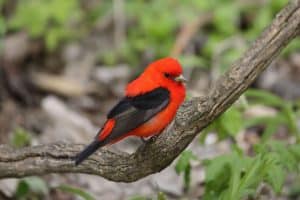
Visitors to Point Pelee in May are almost guaranteed to see magnificent scarlet tanagers – Greg Piasetzki
Once again this year, I made my annual pilgrimage to Point Pelee with friends Jim Cashmore, Mitch Brownstein, Brian Wales, Greg Piasetzki and Clayton Vardy. When we arrived on May 10 after a five and a half hour drive, early migrants like sparrows and kinglets were still much in evidence. A nice surprise, however, was getting close-up views of at least eight black-throated blue warblers. Over the course of the week, new species arrived daily, especially when a flow of air from the south provided a tail wind.
Carolinian zone
Although we’ve been going to Pelee for years, it’s always exciting to become reacquainted with species we rarely see in the Kawarthas. These include orchard orioles, white-eyed vireos, yellow-breasted chats, Carolina wrens, blue-gray gnatcatchers, prothonotary warblers and rarer birds like summer tanagers. The Carolinian forest, too, is quite different with abundant hackberry trees interspersed with eastern redbud, Chinquapin oak, sassafras, shagbark hickory and American sycamore. Many of the trees support huge vines of wild grape, Virginia creeper and especially poison ivy. The latter are easily identifiable by the numerous hairs that anchor the thick stems to the trunk. The forest floor is covered with wide diversity of flowers like sweet cicely, spring beauty, appendaged waterleaf and invasive garlic mustard.
Festival of Birds
Every May, the Friends of Point Pelee organize the Festival of Birds. This year’s festival featured birding and wildflower hikes, twilight hikes, photography walks and a shorebird celebration at nearby Hillman Marsh Conservation Area. Here, volunteers like Jean Irons explained the basics of sandpiper and plover identification. There were also special presentations on everything from warbler and sparrow ID to learning to bird by ear. A welcoming touch this year was the free admission to the Park as part of the Canada 150 celebration. The Friends also host a very popular birder’s breakfast and lunch.
Birders at Pelee take regular breaks at the visitors centre, where naturalists are on hand to answer questions and give suggestions as to where to go. You can also consult the sightings board to see where species of special interest have been observed that day. Quite often, the birds remain in the same area for hours or even days. You will also find a great bookstore and displays set up by various groups like Quest Nature Tours and the Ontario Field Ornithologists.
Highlights
Each year offers a different mix of highlights. This year, great views of prothonotary warblers was one of them. On the Woodland Trail at Pelee and then again on the Tulip Tree Trail at Rondeau, we watched as they searched for food along the edge of wooded swamps. Their brilliant orange-yellow head and blue-gray wings produced a non-stop chorus of “wow!” from the appreciative birders. At one point, a spectacular male was hopping around at people’s feet. Photographers couldn’t stop clicking.
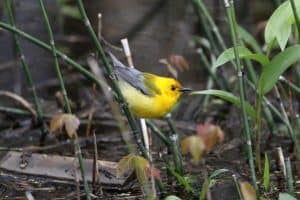
Point Pelee is a photographer’s delight with spectacular species like prothonotary warblers – Greg Piasetzki
Other memories that made the spring of 2017 special were the hundreds of northbound blue jays streaming overhead; the great views of spectacular male warblers like the northern parula, the blackburnian and the blue-winged; a tired and hungry scarlet tanager foraging in a pile of rocks and oblivious to the crowd only metres away; the chestnut-sided warbler that briefly landed on Mitch’s shoulder; an American woodcock and its chicks feeding along a muddy trail; observing orioles and grosbeaks building their nests; the tom turkeys displaying to females with tail fanned and body feathers puffed out; a winter wren pouring out its ridiculously long, 132-note song; a black-billed and yellow-billed cuckoo perched side by side in a tree just metres overhead; the abundance of wood thrushes, Swainson’s thrushes and veerys; and getting great views of the subtle differences between similar species like Forster’s terns and common terns and American golden plovers and black-bellied plovers.
Birding’s allure
Despite the thousands of people in the Park and the sometimes-congested trails, birders show an unwavering respect for the birds and for fellow birdwatchers. Rarely do people speak in a loud voice or push their way past others. It’s not unusual to be surrounded by a dozen other birders but to still feel you have the silence of the woods to yourself. It’s also wonderful to be in the company of so many people of similar interests, to chat with visitors from all over North America and the United Kingdom and to be part of the instantaneous “sightings grapevine” in which birders share the location of sought-after species. People also help each other with identification problems and love to share what species are just ahead on the trail.
Pelee also reminds me each year of why birding is so appealing. At its essence, bird-watching is an exercise in focused awareness. Yes, at one level, it is a hobby, but it is also a powerful means of developing mindfulness. When you are fully focused on finding, identifying or simply watching a given bird, it is possible to live entirely in the moment as your senses completely take over and any intrusive thoughts are swept away. There is so much information for your senses to take in: the beauty, numbers and diversity of the bird themselves, the rich orchestra of different songs, the smell of the spring air and the warmth of the May sun. By learning to see, listen, smell and feel, birding teaches us to enjoy all that our senses have to offer. There is also great satisfaction in drawing upon your knowledge of habitat, time of year, song, behaviour and field marks to make an identification. Sometimes, however, you just don’t know. This is especially true for look-alike birds like many of the vireos and flycatchers.
Personally, I try to focus my attention on bird song. It provides an almost instantaneous picture of the diversity of species present as well as the number of individual birds. The soundscape at Pelee and Rondeau is dominated by the voices of Baltimore orioles, yellow warblers and red-winged blackbirds. The challenge, however, is to coax your brain to push these more common sounds into the background, so that the voices of less common species can be detected. This year, the flute-like song of the wood thrush stood out all week long and was beautiful to hear.
When we left Point Pelee, we headed east to Rondeau Provincial Park near Blenheim. A stop at the town’s sewage lagoon provided great views of shorebirds, five species of swallows and numerous ruddy ducks. Rondeau offers a quiet counterbalance to Pelee’s frenzy. The birding can be almost as good, but there are far fewer visitors. It is also a botanist’s delight with spectacular tulip trees, diverse wildflowers and intriguing ferns. The visitors centre provides many of the same services as at Pelee but on a smaller scale. It also has a busy array of feeders that provide great photo opportunities. A visit to either – or both – of these parks is no less than a celebration of a southern Ontario spring.
If you plan to go next year, book now. Accommodation can be especially difficult to find in the Point Pelee area. For visitor information, go to festivalofbirds.ca
